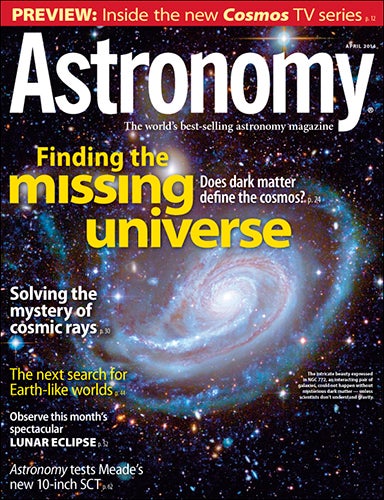
WAUKESHA, Wis. – When you look up at the night sky, do you feel that something is missing? If you don’t, you should. Eighty-one years ago, astronomers discovered that much of the cosmos’ contents was invisible. They saw extra gravity pulling material around galactic centers, but they found no extra mass to account for that force. They deemed their conundrum the “missing mass problem” and came up with a partial solution: dark matter.
Dark matter, an invisible substance of unknown quality, character, and origin that permeates the universe, neither emits nor reflects light. But it makes up 85 percent of the cosmos’ mass. Or does it? The idea has some detractors, who say that the problem is not “missing mass” but a misunderstanding of gravity itself: Scientists need to modify Newton’s original ideas, and then the mathematical need to understand the universe via mysterious, elusive dark matter will disappear.
To find out more about which idea holds more weight, pick up the April issue of Astronomy, on newsstands March 4, and read Bob Berman’s article “The missing universe.”
“Cosmos: A SpaceTime Odyssey“
Whether you watched Carl Sagan’s original Cosmos series in its heyday, streamed it online last year, or have never even heard of it, get excited about this year’s resurrection of that iconic television show. Neil deGrasse Tyson hosts the new version, which will debut March 9 on FOX. Senior Editor Michael Bakich gives the details – and some comments and insights from Sagan’s widow, Ann Druyan – in “Cosmos: A SpaceTime Odyssey.”
“Solving the mystery of cosmic rays”
The most powerful particles in the universe – cosmic rays – are also some of the most mysterious. They come from all over, nearby and far away, and when they hit Earth’s atmosphere, they create showers of lower-energy particles that can be damaging to both humans and electronics. Even before they cross our planet’s boundary, they can slam into satellites and inhabited missions like the International Space Station. In “Solving the mystery of cosmic rays,” Angela Olinto describes the latest in ray research – what’s known, what’s not, and what’s to come.
“The next search for Earth-like worlds”
Just 20 years ago, no one knew for sure if our solar system was the only one with planets. Now, thanks to ground-based telescopes, new techniques, and dedicated spacecraft, astronomers have found more than 1,000 worlds beyond our backyard. But with the exoplanet workhorse, Kepler, out of commission, how will the hunt for new worlds proceed? In “The next search for Earth-like worlds,” Associate Editor Liz Kruesi discusses the future of this burgeoning astronomical field.
April sky events visible without optical aid
- April 6 – The Moon passes 5° south of Jupiter in the evening sky.
- April 8 – Mars reaches its 2014 peak of magnitude –1.5.
- April 15 – A total lunar eclipse is visible to observers across the Americas and the Pacific Ocean.
- April 17 – The Moon passes just south of Saturn in the early morning.
- April 22 – The Lyrid meteor shower peaks.
Also in the April 2014 Astronomy
- “Observe April’s spectacular lunar eclipse” – Senior Editor Michael Bakich clues you in on the details of this month’s lunar eclipse, the first in more than more than two years. Visible in North America, this event will thrill you, as will the similar one that occurs in October.
- “Using solar power to view the stars” – Amateur astronomy can be sustainable – and you can use our home star to better view more distant suns. Learn more about how Alan H. Midkiff and Emily A. Mailhot accomplished such a green feat at their New Jersey observatory.
- “How Terry Mann captures Earth and Sky” –
Sometimes, night-sky photography is tranquil. Other times – like when park rangers and bears come after you – it’s dangerous. Photographer Terry Mann dishes on the risks she’s willing to take to get the perfect shot. - “Astronomy tests Meade’s new 10-inch SCT” – Craig and Tammy Temple check out the LX850, an affordable large-aperture option.
- “The Sky this Month” – Exclusive star charts will guide you through April’s night sky.
- The April issue of Astronomy also includes Astro News, Ask Astro, Snapshot, Breakthrough, Bob Berman’s Strange Universe, Stephen James O’Meara’s Secret Sky, Glenn Chaple’s Observing Basics, Adam Block’s Cosmic Imaging, Erika Rix’s Astro Sketching, Cosmic World, Letters, Web Talk, New Products, Reader Gallery, and Final Frontier.









